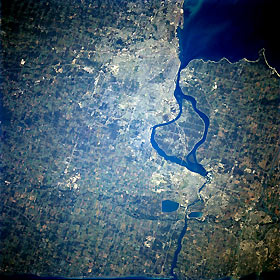
Enregistrez gratuitement cette image
en 800 pixels pour usage maquette
(click droit, Enregistrer l'image sous...)
|
|
Réf : T02118
Thème :
Terre vue de l'espace - Fleuves - Rivières - Lacs (517 images)
Titre : Niagara River, Canada and U.S.A. October 1994
Description : (La description de cette image n'existe qu'en anglais)
The Niagara River forms part of the international boundary between the United States and Canada. Water exiting the eastern end of Lake Erie creates this north-flowing river, which eventually empties into the southwestern part of Lake Ontario (not shown in this photograph). The white water created by the waterflow over world-famous Niagara Falls is barely visible where the Niagara River narrows northwest of Grand Island, the large island that is completely encircled by the Niagara River on the U.S. side of the international border. Niagara Falls was formed approximately 10 000 years ago as the retreating glaciers of the last continental ice sheets exposed the Niagara escarpment, thus permitting the waters of Lake Erie to flow north, over the scarp, to Lake Ontario. The two cities adjacent to the Niagara Falls watercourse are Niagara Falls, New York (east of the river), and Niagara Falls, Ontario, Canada (west of the river). Each city has a population of more than 80 000. Two reservoirs are visible immediately north of these cities. The Welland Canal, approximately 7 miles (11 kilometers) west of the Niagara River, is part of the much larger Saint Lawrence Seaway that allows oceangoing vessels to travel between the Atlantic Ocean and the Great Lakes. This near-vertical photograph reveals much detail for Buffalo (south-central portion of the photograph), a major transshipment point for goods that are shipped by water through the Great Lakes. Some identifiable manmade features are major highways, street patterns, port facilities along Lake Erie, the Buffalo downtown district, and Greater Buffalo International Airport (east of downtown). Cultivated field patterns are visible on either side of the international border.
|
|

